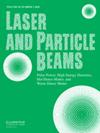磁化等离子体中超强高斯激光脉冲的相对论纵向自压缩
IF 1.9
4区 物理与天体物理
Q4 PHYSICS, APPLIED
引用次数: 0
摘要
本文对超强高斯激光脉冲在磁化等离子体中存在相对论非线性时的纵向自压缩进行了初步研究。在非线性薛定谔方程和高阶近轴(非近轴)近似下的一维几何中进行了这项研究。推导了自压缩和自聚焦的非线性微分方程,并采用解析和数值方法进行了求解。介电函数和椭圆函数被扩展到r(径向距离)的四次方。探讨了初始参数,即入射激光强度、磁场和初始脉冲持续时间对相对论高斯激光脉冲压缩的影响。结果与准轴射线近似进行了比较。研究发现,在非近轴区域,脉冲压缩和压缩后的脉冲强度显著增强。观察到,高强度激光脉冲的压缩与激光束强度(a0)、磁场(ωc)和初始脉冲宽度(τ0)有关。初步结果表明,增大a0、ωc和τ0的值,脉冲压缩效果更好。本文章由计算机程序翻译,如有差异,请以英文原文为准。
Relativistic longitudinal self-compression of ultra-intense Gaussian laser pulses in magnetized plasma
This article presents a preliminary study of the longitudinal self-compression of ultra-intense Gaussian laser pulse in a magnetized plasma, when relativistic nonlinearity is active. This study has been carried out in 1D geometry under a nonlinear Schrodinger equation and higher-order paraxial (nonparaxial) approximation. The nonlinear differential equations for self-compression and self-focusing have been derived and solved by the analytical and numerical methods. The dielectric function and the eikonal have been expanded up to the fourth power of r (radial distance). The effect of initial parameters, namely incident laser intensity, magnetic field, and initial pulse duration on the compression of a relativistic Gaussian laser pulse have been explored. The results are compared with paraxial-ray approximation. It is found that the compression of pulse and pulse intensity of the compressed pulse is significantly enhanced in the nonparaxial region. It is observed that the compression of the high-intensity laser pulse depends on the intensity of laser beam (a0), magnetic field (ωc), and initial pulse width (τ0). The preliminary results show that the pulse is more compressed by increasing the values of a0, ωc, and τ0.
求助全文
通过发布文献求助,成功后即可免费获取论文全文。
去求助
来源期刊

Laser and Particle Beams
PHYSICS, APPLIED-
CiteScore
1.90
自引率
11.10%
发文量
25
审稿时长
1 months
期刊介绍:
Laser and Particle Beams is an international journal which deals with basic physics issues of intense laser and particle beams, and the interaction of these beams with matter. Research on pulse power technology associated with beam generation is also of strong interest. Subjects covered include the physics of high energy densities; non-LTE phenomena; hot dense matter and related atomic, plasma and hydrodynamic physics and astrophysics; intense sources of coherent radiation; high current particle accelerators; beam-wave interaction; and pulsed power technology.
 求助内容:
求助内容: 应助结果提醒方式:
应助结果提醒方式:


